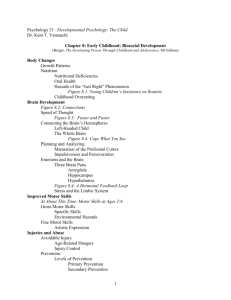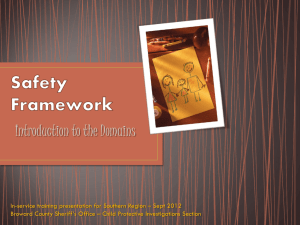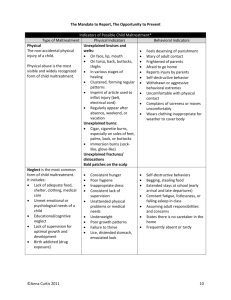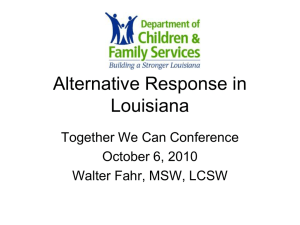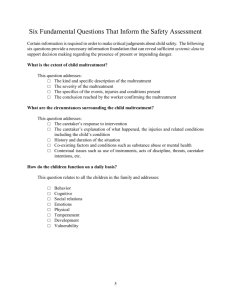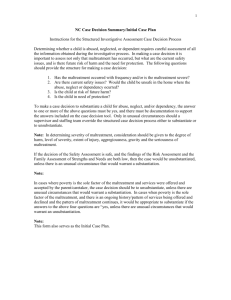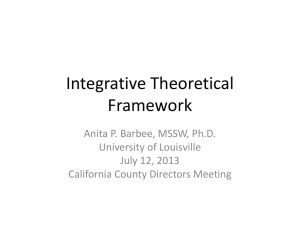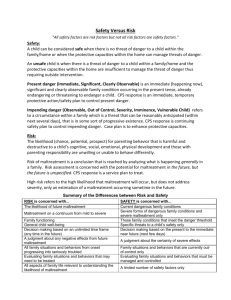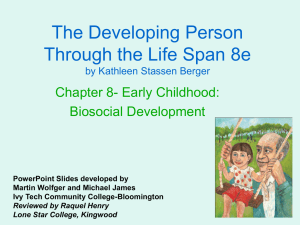301 Russell Syllabus S10 - deafed-childabuse-neglect
advertisement
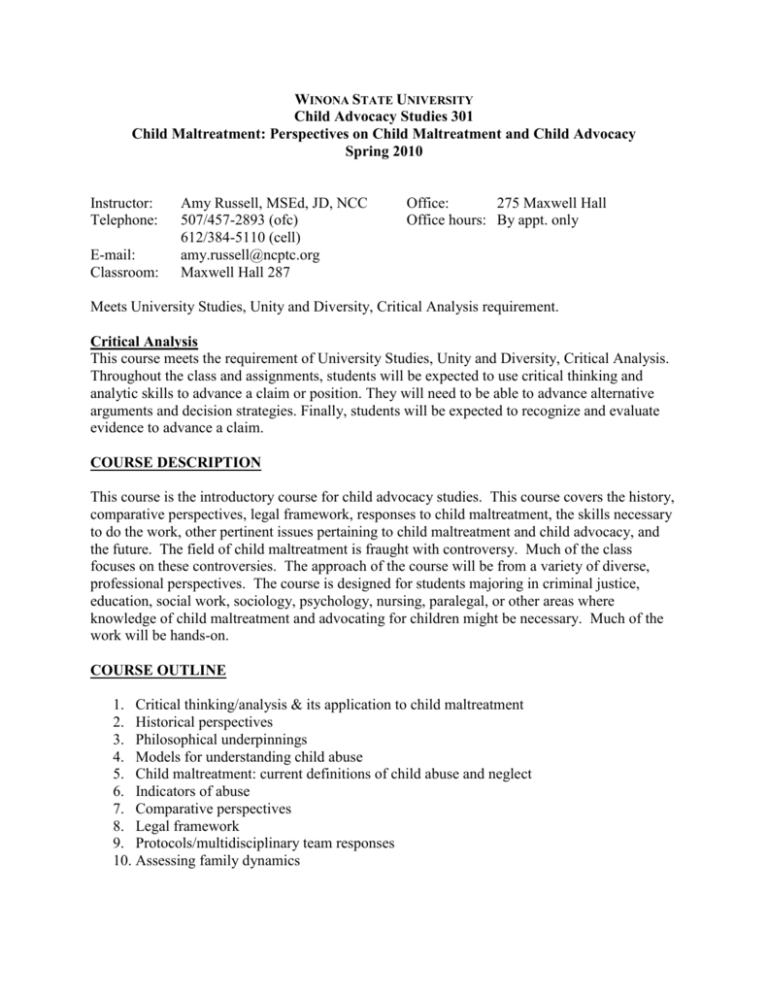
WINONA STATE UNIVERSITY Child Advocacy Studies 301 Child Maltreatment: Perspectives on Child Maltreatment and Child Advocacy Spring 2010 Instructor: Telephone: E-mail: Classroom: Amy Russell, MSEd, JD, NCC 507/457-2893 (ofc) 612/384-5110 (cell) amy.russell@ncptc.org Maxwell Hall 287 Office: 275 Maxwell Hall Office hours: By appt. only Meets University Studies, Unity and Diversity, Critical Analysis requirement. Critical Analysis This course meets the requirement of University Studies, Unity and Diversity, Critical Analysis. Throughout the class and assignments, students will be expected to use critical thinking and analytic skills to advance a claim or position. They will need to be able to advance alternative arguments and decision strategies. Finally, students will be expected to recognize and evaluate evidence to advance a claim. COURSE DESCRIPTION This course is the introductory course for child advocacy studies. This course covers the history, comparative perspectives, legal framework, responses to child maltreatment, the skills necessary to do the work, other pertinent issues pertaining to child maltreatment and child advocacy, and the future. The field of child maltreatment is fraught with controversy. Much of the class focuses on these controversies. The approach of the course will be from a variety of diverse, professional perspectives. The course is designed for students majoring in criminal justice, education, social work, sociology, psychology, nursing, paralegal, or other areas where knowledge of child maltreatment and advocating for children might be necessary. Much of the work will be hands-on. COURSE OUTLINE 1. Critical thinking/analysis & its application to child maltreatment 2. Historical perspectives 3. Philosophical underpinnings 4. Models for understanding child abuse 5. Child maltreatment: current definitions of child abuse and neglect 6. Indicators of abuse 7. Comparative perspectives 8. Legal framework 9. Protocols/multidisciplinary team responses 10. Assessing family dynamics CAST 301 Syllabus Spring 2010 Page 2 11. Overview of responses to child maltreatment 12. Understanding the medical issues 13. Unresolved issues of care and service providers 14. Responsibilities of professionals OBJECTIVES Students will: 1. Learn about and understand how to apply a model of critical thinking/analysis to child maltreatment issues and research. 2. Understand the historical trends in child maltreatment and child advocacy. Through lectures and readings students will be given the history of the treatment of children including a brief world history and US history. 3. Understand the philosophical underpinnings of responses to children and child maltreatment. Through lectures and readings students will be exposed to the different beliefs through time and through cultures that have shaped the responses to child maltreatment. 4. Understand their own values and perceptions and the impact those could have on their practice. Be able to recognize, using critical thinking skills, when their own values and beliefs interfere with their ability to be objective when working with a client. In class exercises will be used to help students gain insight into their own values and beliefs. Students will also have case studies to review and problem-solve. They will be expected to offer sound reasoning for case plans. Students will learn to distinguish between actual fact, and interpretation of an incident offered as fact. They will also learn, through exercises and case planning, the difference between absolute knowledge and relative knowledge. 5. Become knowledgeable about both civil and criminal laws involved in child maltreatment in selected states. Become aware of the outcomes of child maltreatment laws; be able to critique the effectiveness of the laws and the unexpected outcomes. Students will develop questions for speakers to elicit such information. They will also be encouraged to interview professionals in the field. 6. Become aware of the various issues having to do with child maltreatment and understand the opposing positions surrounding those issues. Be able to provide sound arguments for either position. 7. Become aware of the different perspectives of a prosecuting attorney versus a defense attorney. Students will be given concrete incidents and have to view them from these two opposing perspectives. For example, how would each of these attorneys view a diaper saturated with urine? 8. Understand the roles of the various professionals working in the field and their different world views. Understand how various professionals treat situations differently based on their professional socialization. Class exercises will be used to achieve this objective. Understand how to work effectively with individuals from different professions. 9. Become aware of cultural differences and how they impact responses to child maltreatment. Case studies will involve families from diverse cultures. Also, one of the assignments concerns specific behaviors from different cultures. CAST 301 Syllabus Spring 2010 Page 3 10. Become knowledgeable about the complexities of working in the field of child maltreatment. 11. Understand how to identify and respond to child maltreatment. 12. Understand the skills necessary to do the work. Begin to practice the skills necessary to do good work. Be able to analyze case studies using evidence-based research. Students will be given case studies and be expected to use evidence-based research to support their plans. Students will also learn to critique the reliability of their sources and to recognize biases where they occur. In preparation, students will be shown in class a variety of sources and taught how to look for strengths and weaknesses and possible biases. 13. Become aware of what can be done to both prevent child maltreatment and intervene effectively when it does occur. Lectures, readings, and class assignments will address this area. TEXTS Primary Text 1. Miller-Perrin, C.L. & Perrin, R.D. (2007). Child Maltreatment: An Introduction (2nd Ed.). Thousand Oaks: Sage Publications. Supplemental Readings may be assigned throughout the course INSTRUCTIONAL PLAN This course will include lectures, small-group discussions and role-play exercises; students will examine relevant case studies, and will complete exercises and assignments that require them to demonstrate mastery of the analyses and skills developed in the course. COURSE REQUIREMENTS AND METHODS OF EVALUATION 1. 2. 3. 4. 5. 6. Attendance & participation Controversial Topic Group Presentation Case Study Child Observation Project Final Quizzes TOTAL Grading Scale 92-100 = A 84-91=B 74-83=C 62-73=D 5% 15% 20% 15% 25% 20% 100% CAST 301 Syllabus Spring 2010 Page 4 Assignments 1. Attendance and class participation are expected. All unexcused absences will count against students when final grades are calculated. Students may be excused only when they contact at least one of the professors via phone or email before the class they expect to miss. If seeking excuse via phone, students should always leave a message, and follow up with an email to both professors as soon as possible. 2. Group Presentations – Controversial Issues in Child Maltreatment A. Student groups (3-4 people) will choose a “controversial” topic and will conduct a literature review exploring all sides of the issue. Groups will turn in detailed outlines of their findings, an annotated bibliography, and a copy of any and all materials presented in class. Students will critique the reliability and validity of each source included in their bibliographies. B. Each item submitted should include, at minimum, the name/ID number of the group “chair” C. Initial literature review and presentation outline due in D2L dropbox on February 22nd D. Electronic copy of the presentation materials are due in D2L dropbox before individual presentations starting March 22nd. E. Possible Topics: i. Firearms homes ii. Shaken baby syndrome iii. Minnesota’s family assessment vs. CHIPS petitions iv. Do all abused children need therapy? v. Parental rights vs. parens patriae vi. Laws holding parents responsible for allowing children to witness domestic violence vii. Family preservation vs. out-of-home placement viii. Corporal punishment ix. Permitting cultural specific actions with children, e.g. cupping and coining x. Laws allowing parents to forego medical treatment based on religious beliefs xi. Grandparents rights/visitation xii. Parental alienation syndrome xiii. Tax on pornography to fund child sexual abuse investigations xiv. Termination vs. suspension of parental rights / Reinstatement of parental rights xv. Same sex foster / adoptive parents xvi. Mothers in the military (deployment with no alternative caretakers) 3. Case Study – Students will be given a case study at the beginning of the semester. They will work in groups (of 3-4 persons) on the case throughout the semester. The case and the questions to be answered are posted on D2L. Students are to write a group report CAST 301 Syllabus Spring 2010 Page 5 using evidence-based research. For this exercise, students may use Napier & Gershenfeld’s model for rational problem solving. A. Include references as appropriate and use APA format (if other, please indicate what); 1” margins; 12 pt. font; double-spaced; include all student names on cover page and group chair’s name/ID and page number on each page B. Due in D2L dropbox before class April 19, 2010 4. Child Observation Project – Each student is to spend five hours interacting with young children they don’t know—ages 2-5. Use knowledge gained from class and readings about child development during these interactions. Write a paper using critical thinking discussing the experience. A. Minimally, address the following issues: In observing and thinking about these children, how objective were you? In what ways did you find yourself observing children through your own personal experiences? How easy or hard was it to not judge situations? For example, do your standards of cleanliness affect how you view a child? Do your standards or expectations of how children should behave impact how you viewed the children during your experience? Finally, how do you see and interact with children now as compared to before this class? B. The time spent with the children must be verified. Documentation forms are due in class March 22, 2010. Failure to provide documentation will lower your grade. C. Use APA format (if other, please indicate what); 1” margins; 12 pt. font; doublespaced; student name/ID and page number on each page D. Due in D2L dropbox before class March 22, 2010 5. Quizzes – Two throughout semester based on lectures and reading assignments 6. Final Exam – Due May 6, 2010 at 11:59 p.m. 7. IF extra credit opportunities are offered, student submissions will be considered only if they adhere to the directions for the specific assignment/activity offered. Appropriate extra credit submissions will be used to “bump” students up to the next higher grade if students are within three (3) points of that grade. NOTE: All written work in this class must be grammatically correct, well-researched and well written. All work should be typed and double-spaced, with student ID numbers and page numbers on each page, unless the assignment specifically indicates otherwise. Work should demonstrate students have put time, thought and effort into it. Work should demonstrate students understand the content and information. Papers should have the appropriate documentation and references. Citations must be placed appropriately throughout the paper. Incorrect or poor grammar, misspelled words, typographical errors, late submissions and plagiarism will result in significantly lowered grades. COURSE BIBLIOGRAPHY CAST 301 Syllabus Spring 2010 Page 6 Posted on D2L.
